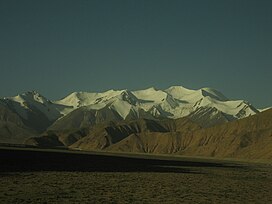Tanggula Mountains
| Tanggula Mountains | |
|---|---|
| Tangla, Tanglha, Dangla Mountains | |
 Tanggula Mountains viewed from Qinghai. | |
| Highest point | |
| Peak | Geladaindong Peak |
| Geography | |
| Country | |
| Province/Region | Qinghai and Tibet Autonomous Region |
| Range coordinates | 33°30′00″N 91°04′12″E / 33.50000°N 91.07000°E |
The Tanggula (
province
.
Tanggula is the source of the
Yangtze River. It functions as a dividing range between the basin of the Yangtze in the north and the endorheic basin
of northeastern Tibet in the south.
Overview
The elevations of the main ridge average over 5,000 m (16,404 ft). The Yangtze River originates in this mountain range;
The
Tanggula Mountain Pass. This is the highest point of the Qinghai-Tibet Railway, and the highest point of any railway in the world, at 5,072 metres (16,640 feet) above sea level.[4] On account of snow and occasional road accidents, highway closures and concomitant traffic delays are not uncommon.[5]
The mountains lie within the
See also
Wikimedia Commons has media related to Tanggula Mountains.
References
- ^ "Tanggula Mountains". Encyclopædia Britannica. Retrieved 2007-07-03.
- ^ "Desperate Times at the Headwaters of the Yangtze". Archived from the original on 2007-10-09. Retrieved 2007-07-03.
- S2CID 129888580.
- ^ "New height of world's railway born in Tibet". China View. Archived from the original on September 13, 2005. Retrieved 2007-07-03.
- ^ Plateau traffic jam
- doi:10.1641/0006-3568(2001)051[0933:TEOTWA]2.0.CO;2.)
{{cite journal}}: CS1 maint: multiple names: authors list (link
Further reading
- Duan, Hong-yu; Yao, Xiao-jun; Liu, Shi-yin; Gao, Yong-peng; Qi, Miao-miao; Liu, Juan; Zhang, Da-hong; Li, Xiao-feng (2019-11-01). "Glacier change in the Tanggula Mountains, Tibetan Plateau, in 1969–2015". Journal of Mountain Science. 16 (11): 2663–2678. S2CID 201716065.
- Wang, Jing; Wang, Chao; Tang, Yixian; Zhang, Hong; Duan, Wei; Dong, Longkai (2021). "Investigation for the Surface Deformation of Tanggula Mountain Permafrost Using Distributed Scatterer INSAR". 2021 IEEE International Geoscience and Remote Sensing Symposium IGARSS. pp. 5358–5361. S2CID 238751460.
